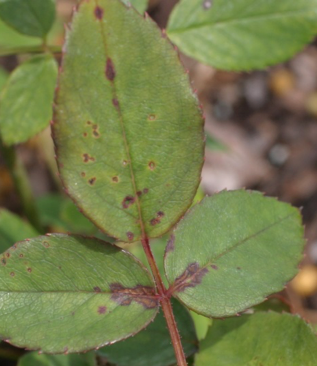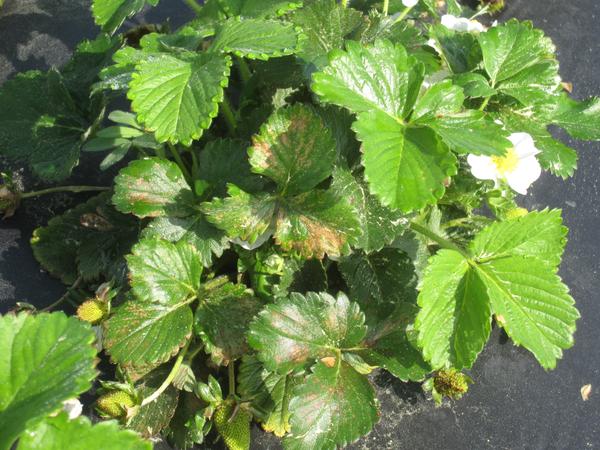Problem
Herbicide injury caused from protoporphyrinogen oxidase (PPO, PPG or protox) inhibitors including acifluorfen, flumioxazin, oxyfluorfen, fomesafen, sulfentrazone, oxadiazon, and others.
Symptoms
- Interveinal chlorosis, bronzing, desiccation and then necrosis.
- Foliar necrosis – spots, margins or general necrosis depending on the amount of spray exposure.
- Petiole and tender stem necrosis.
- Fruit lesions and necrosis.
Less commonly:
- Leaf mid-vein reddening followed by necrosis.
- Dark red leaf spots followed by necrotic leaf spots.

Darkening and necrosis of mid-veins in young knockout rose foliage, from root uptake of flumioxazin. Two weeks after treatment.
J. Neal CC BY-NC-SA 4.0

Necrosis of young tomato fruit from flumioxazin spray drift, three days after treatment.
B. Lassiter CC BY-NC-SA 4.0

Necrosis of tomato foliage and stems from flumioxazin spray drift; three days after treatment.
B. Lassiter CC BY-NC-SA 4.0

Spotting and necrosis on grape leaves from flumioxazin spray drift, three days after treatment.
B. Lassiter CC BY-NC-SA 4.0

Spotting and necrosis on strawberry leaves from flumioxazin spray drift, three days after treatment.
B. Lassiter CC BY-NC-SA 4.0

Fomesafen applied postemergence over the top of strawberry one week after treatment.
K. Jennings CC BY-NC-SA 4.0
Plant Entry and Symptom Expression
PPO inhibitors can be applied pre or postemergence leading to foliar absorption in seedlings and some upward translocation. Light is needed to activate assimilated PPO inhibitors causing rapid cell membrane destruction on young seedling leaves, petioles and stems shortly after emergence. Spray drift to foliage results in rapid necrosis of tender tissues. More mature leaves and stems may not express symptoms. Various PPO herbicides display like symptomologies but may differ due to application timing and differential sensitivity in crops and weeds.
Similar Problems
PPO inhibitor injury may be confused with symptoms from:
- Cell membrane disruptors such as paraquat, diquat, herbicidal oils and fatty acids.
- Glufosinate.
- Classical PS II, as-triazine such as metribuzin.
- Rapid action PS II, benzothiadiazole such as bentazon.
- Desiccation, salt injury, frost damage.
Herbicide Mode of Action Category
WSSA – 14
HRAC – E
Useful Resources
North Carolina Agricultural Chemicals Manual
Southern Region Small Fruit Consortium
Southeastern US Vegetable Crop Handbook
Weed Management in Nurseries, Landscapes & Christmas Trees Information Portal
Herbicide Handbook, Weed Science Society of America
Applied Weed Science: Including the Ecology and Management of Invasive Plants (3rd Edition), Merrill Ross & Carol Lembi, pages 168, 178-179, 273-277
Publication date: Dec. 11, 2015
N.C. Cooperative Extension prohibits discrimination and harassment regardless of age, color, disability, family and marital status, gender identity, national origin, political beliefs, race, religion, sex (including pregnancy), sexual orientation and veteran status.


